Solar eclipse of June 8, 1956
| Solar eclipse of June 8, 1956 | |
|---|---|
| Type of eclipse | |
| Nature | Total |
| Gamma | −0.8934 |
| Magnitude | 1.0581 |
| Maximum eclipse | |
| Duration | 285 s (4 min 45 s) |
| Coordinates | 40°48′S 140°42′W / 40.8°S 140.7°W |
| Max. width of band | 429 km (267 mi) |
| Times (UTC) | |
| Greatest eclipse | 21:20:39 |
| References | |
| Saros | 146 (24 of 76) |
| Catalog # (SE5000) | 9412 |
A total solar eclipse occurred at the Moon's descending node of orbit between Friday, June 8 and Saturday, June 9, 1956, with a magnitude of 1.0581. A solar eclipse occurs when the Moon passes between Earth and the Sun, thereby totally or partly obscuring the image of the Sun for a viewer on Earth. A total solar eclipse occurs when the Moon's apparent diameter is larger than the Sun's, blocking all direct sunlight, turning day into darkness. Totality occurs in a narrow path across Earth's surface, with the partial solar eclipse visible over a surrounding region thousands of kilometres wide. It began near sunrise over New Zealand on June 9 (Saturday), and ended west of South America on June 8 (Friday).
Eclipse details[edit]
- Eclipse Magnitude: 1.05810
- Eclipse Obscuration: 1.11958
- Gamma: -0.89341
- Saros Series: 146th (24 of 76)
- Greatest Eclipse: 08 Jun 1956 21:20:07.7 UTC (21:20:39.3 TD)
- Ecliptic Conjunction: 08 Jun 1956 21:29:07.4 UTC (21:29:39.0 TD)
- Equatorial Conjunction: 08 Jun 1856 21:20:45.9 UTC (21:21:17.5 TD)
- Sun right ascension: 5.13
- Moon right ascension: 5.13
- Earth's shadow right ascension: 17.13
- Sun declination: 22.9
- Moon declination: 22
- Earth's shadow declination: -22.9
- Sun diameter: 1890.4 arcseconds
- Moon diameter: 1985.8 arcseconds
- Path Width at Greatest Eclipse: 428.7 km (266.4 mi)
- Path Width at Greatest Duration: 428.7 km (266.4 mi)
- Central Duration at Greatest Eclipse: 4 minutes, 44.85 seconds
- Central Duration at Greatest Duration: 4 minutes, 44.86 seconds
Related eclipses[edit]
Eclipses in 1956[edit]
- A partial lunar eclipse on May 24, 1956.
- A total solar eclipse on June 8, 1956.
- A total lunar eclipse on November 18, 1956.
- A partial solar eclipse on December 2, 1956.
Metonic[edit]
- Preceded by: Solar eclipse of August 20, 1952
- Followed by: Solar eclipse of March 27, 1960
Tzolkinex[edit]
- Preceded by: Solar eclipse of April 28, 1949
- Followed by: Solar eclipse of July 20, 1963
Half-Saros[edit]
- Preceded by: Lunar eclipse of June 3, 1947
- Followed by: Lunar eclipse of June 14, 1965
Tritos[edit]
- Preceded by: Solar eclipse of July 9, 1945
- Followed by: Solar eclipse of May 9, 1967
Solar Saros 146[edit]
- Preceded by: Solar eclipse of May 29, 1938
- Followed by: Solar eclipse of June 20, 1974
Inex[edit]
- Preceded by: Solar eclipse of June 29, 1927
- Followed by: Solar eclipse of May 19, 1985
Triad[edit]
- Preceded by: Solar eclipse of August 7, 1869
- Followed by: Solar eclipse of April 9, 2043
Solar eclipses of 1953–1956[edit]
This eclipse is a member of a semester series. An eclipse in a semester series of solar eclipses repeats approximately every 177 days and 4 hours (a semester) at alternating nodes of the Moon's orbit.[1]
The partial solar eclipses on February 14, 1953 and August 9, 1953 occur in the previous lunar year eclipse set.
| Solar eclipse series sets from 1953 to 1956 | ||||||
|---|---|---|---|---|---|---|
| Descending node | Ascending node | |||||
| Saros | Map | Gamma | Saros | Map | Gamma | |
| 116 | July 11, 1953 Partial |
1.4388 | 121 | January 5, 1954 Annular |
−0.9296 | |
| 126 | June 30, 1954 Total |
0.6135 | 131 | December 25, 1954 Annular |
−0.2576 | |
| 136 | June 20, 1955 Total |
−0.1528 | 141 | December 14, 1955 Annular |
0.4266 | |
| 146 | June 8, 1956 Total |
−0.8934 | 151 | December 2, 1956 Partial |
1.0923 | |
Saros 146[edit]
This eclipse is a part of Saros series 146, repeating every 18 years, 11 days, and containing 76 events. The series started with a partial solar eclipse on September 19, 1541. It contains total eclipses from May 29, 1938 through October 7, 2154; hybrid eclipses from October 17, 2172 through November 20, 2226; and annular eclipses from November 30, 2244 through August 10, 2659. The series ends at member 76 as a partial eclipse on December 29, 2893. Its eclipses are tabulated in three columns; every third eclipse in the same column is one exeligmos apart, so they all cast shadows over approximately the same parts of the Earth.
The longest duration of totality was produced by member 26 at 5 minutes, 21 seconds on June 30, 1992, and the longest duration of annularity will be produced by member 63 at 3 minutes, 30 seconds on August 10, 2659. All eclipses in this series occur at the Moon’s descending node of orbit.[2]
| Series members 16–37 occur between 1801 and 2200: | ||
|---|---|---|
| 16 | 17 | 18 |
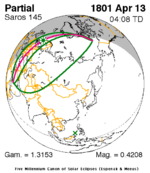 March 13, 1812 |
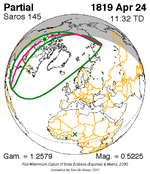 March 24, 1830 |
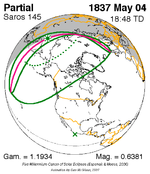 April 3, 1848 |
| 19 | 20 | 21 |
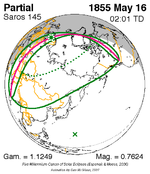 April 15, 1866 |
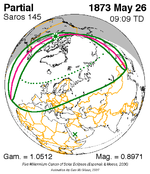 April 25, 1884 |
 May 7, 1902 |
| 22 | 23 | 24 |
 May 18, 1920 |
 May 29, 1938 |
 June 8, 1956 |
| 25 | 26 | 27 |
 June 20, 1974 |
 June 30, 1992 |
 July 11, 2010 |
| 28 | 29 | 30 |
 July 22, 2028 |
 August 2, 2046 |
 August 12, 2064 |
| 31 | 32 | 33 |
 August 24, 2082 |
 September 4, 2100 |
 September 15, 2118 |
| 34 | 35 | 36 |
 September 26, 2136 |
 October 7, 2154 |
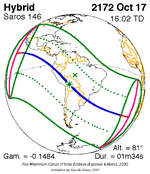 October 17, 2172 |
| 37 | ||
 October 29, 2190 | ||
Notes[edit]
- ^ van Gent, R.H. "Solar- and Lunar-Eclipse Predictions from Antiquity to the Present". A Catalogue of Eclipse Cycles. Utrecht University. Retrieved 6 October 2018.
- ^ "NASA - Catalog of Solar Eclipses of Saros 146". eclipse.gsfc.nasa.gov.
References[edit]
- Earth visibility chart and eclipse statistics Eclipse Predictions by Fred Espenak, NASA/GSFC




